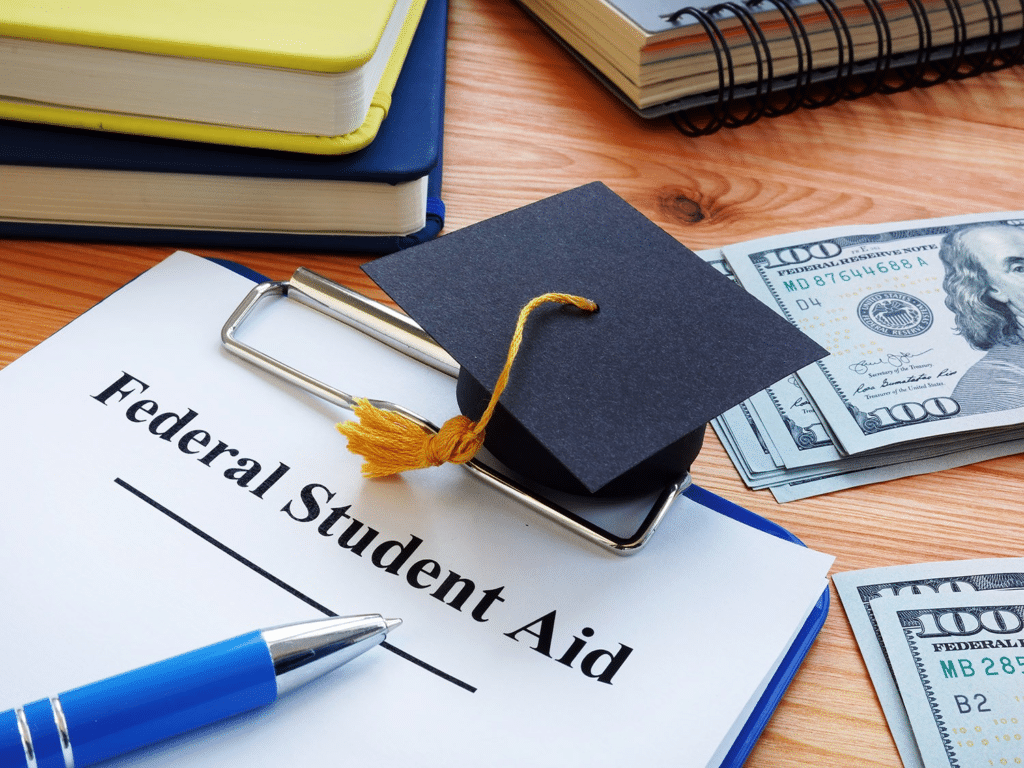Financing a college education can be daunting, but federal student loans are one of the best ways to fund higher education due to their competitive interest rates and flexible repayment options. Understanding the different types of federal loans available can help students make informed decisions and choose the right loan for their needs.
In this article, we’ll explore the various types of federal loans available for students, their eligibility requirements, interest rates, repayment plans, and more. Additionally, we’ll answer some common questions to ensure you understand the ins and outs of federal student loans.
Key Takeaway
Federal student loans are a vital resource for funding education. There are different types of loans based on need, credit history, and school status. It’s crucial to understand the eligibility requirements, loan limits, and repayment options before taking out loans. With responsible borrowing and management, federal student loans can be a helpful tool in achieving educational goals.
What Are Federal Student Loans?

Federal student loans are loans offered by the U.S. government to help students and their families pay for college education. These loans are typically more favorable than private loans, offering benefits such as lower interest rates, income-driven repayment plans, and loan forgiveness options for eligible borrowers.
The most common federal student loans are Direct Subsidized Loans, Direct Unsubsidized Loans, Direct PLUS Loans, and Federal Perkins Loans (although the Perkins Loan program ended in 2017). Below, we’ll dive deeper into each type of federal student loan.
Types of Federal Student Loans
1. Direct Subsidized Loans
What are Direct Subsidized Loans?
Direct Subsidized Loans are federal student loans offered to undergraduate students who demonstrate financial need. The key benefit of these loans is that the federal government pays the interest while the student is enrolled at least half-time, during the grace period after graduation, and during deferment periods.
Eligibility Criteria
To qualify for a Direct Subsidized Loan, you must:
- Be an undergraduate student.
- Have financial need as determined by your Free Application for Federal Student Aid (FAFSA).
- Be enrolled at least half-time in an eligible program at a participating school.
Loan Limits and Interest Rates
- Interest Rate: As of 2023, the interest rate for Direct Subsidized Loans is fixed at 4.99% for undergraduate students.
- Loan Limits: The maximum amount you can borrow in Direct Subsidized Loans varies based on your year in school and dependency status. First-year dependent students can borrow up to $3,500, and by the fourth year, the limit increases to $5,500.
Repayment Plans
Repayment for Direct Subsidized Loans begins six months after you graduate, leave school, or drop below half-time enrollment. The loan term typically spans 10 years, but various repayment options are available, including income-driven plans and deferment options.
2. Direct Unsubsidized Loans
What are Direct Unsubsidized Loans?
Direct Unsubsidized Loans are federal loans available to both undergraduate and graduate students. Unlike Subsidized Loans, these loans are not based on financial need, and interest accrues while the borrower is still in school. Students are responsible for paying the interest, but they can choose to defer it until after graduation.
Eligibility Criteria
Direct Unsubsidized Loans are available to:
- Both undergraduate and graduate students.
- Students who are enrolled at least half-time in an eligible program at a participating school.
- Borrowers do not need to demonstrate financial need.
Loan Limits and Interest Rates
- Interest Rate: The interest rate for Direct Unsubsidized Loans is fixed at 4.99% for undergraduate students and 6.54% for graduate students as of 2023.
- Loan Limits: The borrowing limits vary based on your dependency status and year in school. For example, independent undergraduate students can borrow up to $9,500 for the first year, while graduate students can borrow up to $20,500 annually.
Repayment Plans
Direct Unsubsidized Loans offer the same repayment options as Direct Subsidized Loans, including income-driven repayment plans. However, since interest accrues while you’re in school, it’s important to either pay the interest or make arrangements to defer it.
3. Direct PLUS Loans
What are Direct PLUS Loans?
Direct PLUS Loans are federal loans available to parents of dependent undergraduate students and to graduate or professional students. These loans are credit-based, meaning that the borrower must have a good credit history. They are often used to fill the gap between the cost of education and the amount covered by other financial aid.
Eligibility Criteria
To qualify for a Direct PLUS Loan:
- Parents must be the biological or adoptive parents of a dependent undergraduate student.
- Graduate or professional students can also apply for a Direct PLUS Loan.
- The borrower must not have an adverse credit history. If there is a negative credit history, the borrower may still qualify with a creditworthy co-signer.
Loan Limits and Interest Rates
- Interest Rate: As of 2023, the fixed interest rate for Direct PLUS Loans is 7.54%.
- Loan Limits: The amount you can borrow is limited to the cost of attendance (as determined by the school) minus any other financial assistance you are receiving.
Repayment Plans
Repayment for Direct PLUS Loans begins immediately after the loan is disbursed, but parents or graduate students can request deferment until the student graduates or drops below half-time enrollment. There are also options to extend repayment periods.
4. Federal Perkins Loans (Expired in 2017)

What were Federal Perkins Loans?
Federal Perkins Loans were low-interest federal loans for undergraduate and graduate students with exceptional financial need. The program expired in 2017, but if you received a Perkins Loan prior to its expiration, you are still required to repay it.
Eligibility Criteria
- The Perkins Loan program was available to both undergraduate and graduate students with exceptional financial need.
- The loan amount depended on the student’s financial need and the amount of other aid they received.
Loan Limits and Interest Rates
- Interest Rate: The interest rate for Perkins Loans was fixed at 5%.
- Loan Limits: The maximum loan amount was typically up to $5,500 per year for undergraduate students and $8,000 for graduate students.
Repayment Options for Federal Student Loans
Federal student loans offer a range of repayment plans to help borrowers manage their payments. These plans include:
- Standard Repayment Plan: Fixed monthly payments over 10 years.
- Graduated Repayment Plan: Payments start low and increase every two years, with the loan being paid off in 10 years.
- Income-Driven Repayment Plans: Payments are based on your income and family size. These plans can extend the repayment period beyond 10 years and offer lower monthly payments.
- Pay As You Earn (PAYE) and Revised Pay As You Earn (REPAYE): These plans set your monthly payment based on a percentage of your discretionary income.
- Income-Based Repayment (IBR): Offers flexible payments based on income and family size, with the possibility of forgiveness after 20 or 25 years of qualifying payments.
Here are more detailed topics related to loans, particularly in the context of federal student loans and other types of loans. These topics offer further insight into the broader world of financing education and managing loans effectively.
How to Maximize Your Financial Aid with Federal Student Loans
- Overview: How students can take full advantage of federal student loans by combining them with other financial aid options such as grants, scholarships, and work-study programs.
- Details:
- Tips on how to calculate the total cost of education.
- Strategies for minimizing borrowing by maximizing free financial aid (scholarships, grants).
- Understanding loan limits and how to avoid borrowing more than necessary.
- Discussing the importance of timely FAFSA submission to get the maximum loan eligibility.
Federal Loan Forgiveness Programs: Who Qualifies and How Do They Work?
- Overview: A deep dive into various federal student loan forgiveness programs, including Public Service Loan Forgiveness (PSLF) and Teacher Loan Forgiveness.
- Details:
- Eligibility criteria for federal loan forgiveness.
- Step-by-step guide on how to apply for forgiveness programs.
- Key differences between various loan forgiveness programs.
- Tax implications of loan forgiveness.
Repayment Strategies for Federal Student Loans
- Overview: Understanding the different repayment plans and strategies to manage federal student loan payments effectively.
- Details:
- Breakdown of standard, graduated, and income-driven repayment plans.
- How to select the best repayment strategy based on income, family size, and long-term goals.
- Strategies for paying off loans faster, including making extra payments and refinancing options.
- The impact of loan consolidation and refinancing on repayment.
The Pros and Cons of Federal vs. Private Student Loans
- Overview: A comparison of federal and private student loans, including advantages and disadvantages of each.
- Details:
- Interest rates and repayment options: Which one is better for your financial situation?
- Borrower protections and benefits: Federal loan advantages like deferment, forbearance, and income-driven repayment.
- Loan terms and conditions: Fixed vs. variable rates in private loans.
- When it makes sense to consider private loans over federal loans.
Navigating the FAFSA: Tips for Securing Maximum Financial Aid
- Overview: Understanding how to complete the FAFSA (Free Application for Federal Student Aid) and tips for ensuring you qualify for the maximum aid possible.
- Details:
- Common mistakes to avoid when filling out the FAFSA.
- Understanding Expected Family Contribution (EFC) and how it affects financial aid eligibility.
- The importance of renewal and annual FAFSA submission.
- Special considerations for divorced or separated parents, non-traditional students, and international students.
Understanding Subsidized vs. Unsubsidized Federal Student Loans
- Overview: A closer look at the two major types of federal loans: Subsidized vs. Unsubsidized.
- Details:
- Differences in how interest is paid during school and during the loan’s life.
- Loan eligibility for each type based on need and dependency status.
- Repayment terms and options for both subsidized and unsubsidized loans.
- Which loan type is better for your financial situation and why?
How to Handle Federal Loan Default: Steps to Avoid and Correct Default
- Overview: What to do if you default on a federal student loan and how to prevent it from happening.
- Details:
- The consequences of loan default: Wage garnishment, tax refund offsets, and loss of eligibility for further financial aid.
- Options for resolving loan default: Loan rehabilitation and loan consolidation.
- Steps to avoid default: Managing loan payments and exploring income-driven repayment options.
- Resources for getting back on track if you have defaulted.
The Impact of Interest Rates on Federal Loans
- Overview: How interest rates affect the overall cost of federal student loans and strategies to minimize interest payments.
- Details:
- How federal student loan interest rates are set and how they change each year.
- The difference between fixed and variable interest rates.
- Strategies for minimizing interest payments: Making early payments, paying interest while still in school, and selecting income-driven repayment plans.
- The effect of interest capitalization and when it occurs.
What Happens After You Graduate? Managing Your Federal Student Loan Repayments

- Overview: A guide on managing federal student loan repayments once you graduate, leave school, or drop below half-time enrollment.
- Details:
- Understanding your grace period and when you must start repaying.
- How to set up your loan repayment through servicers.
- Choosing between different repayment plans, such as income-driven repayment or extended repayment.
- Consolidation or refinancing options to consider after graduation.
Federal Student Loan Consolidation: What You Need to Know
- Overview: An in-depth look at federal loan consolidation and whether it’s the right choice for you.
- Details:
- What loan consolidation is and how it works.
- The pros and cons of consolidating federal loans.
- How consolidation can simplify loan management and reduce monthly payments.
- The effect of consolidation on loan forgiveness programs and repayment terms.
Exploring Income-Driven Repayment Plans for Federal Loans
- Overview: A detailed exploration of the various income-driven repayment plans available for federal student loans.
- Details:
- Overview of Income-Driven Repayment Plans (IDR): PAYE, REPAYE, IBR, and ICR.
- How your monthly payment is calculated based on income and family size.
- How long it takes to pay off the loan under IDR plans.
- Loan forgiveness after 20-25 years of qualifying payments under IDR.
The Role of Private Loans in Financing Education
- Overview: A deep dive into private student loans, including when and why you might consider them, and the differences from federal loans.
- Details:
- How private loans differ from federal loans in terms of interest rates, repayment terms, and borrower protections.
- The benefits of private loans for students who exceed federal loan limits.
- Tips on choosing the best private loan provider.
- How credit scores affect private loan eligibility and terms.
Understanding the Federal Loan Servicer: How They Affect Your Loan Repayment
| Topic | Description |
|---|---|
| Maximizing Financial Aid with Federal Loans | Strategies for combining federal loans with other financial aid like scholarships, grants, and work-study programs. |
| Federal Loan Forgiveness Programs | An overview of loan forgiveness options like Public Service Loan Forgiveness (PSLF) and Teacher Loan Forgiveness. |
| Repayment Strategies for Federal Loans | Options for managing and repaying federal loans effectively, including income-driven repayment plans. |
| Federal vs. Private Student Loans | A comparison of federal loans and private loans based on interest rates, benefits, and repayment terms. |
| Navigating the FAFSA | Tips on completing the Free Application for Federal Student Aid (FAFSA) to maximize financial aid eligibility. |
| Subsidized vs. Unsubsidized Federal Loans | A breakdown of Direct Subsidized and Unsubsidized Loans and how they differ in terms of interest and eligibility. |
| Handling Federal Loan Default | Steps to take if you default on a federal student loan and how to prevent default in the future. |
| Impact of Interest Rates on Federal Loans | How interest rates affect the total loan cost and strategies to minimize interest payments. |
| Managing Repayments After Graduation | What to expect and how to manage federal student loan repayments after completing your studies. |
| Federal Loan Consolidation | The pros and cons of consolidating federal student loans and how it affects repayment options. |
- Overview: What federal loan servicers do, how they work with borrowers, and why understanding them is crucial for managing your loans.
- Details:
- The role of federal loan servicers in managing your loan and facilitating repayment.
- How to contact and work with your loan servicer.
- Problems that can arise with servicers and how to resolve them.
- Choosing a loan servicer and understanding their repayment options.
Each of these topics can be expanded into a full-length article, providing valuable insights and guidance for students and borrowers navigating the world of federal student loans and related financing options. Understanding these topics will help borrowers make more informed decisions about their loan choices, repayment strategies, and potential pitfalls.
Read more :How Do Federal Loans Compare to Private Loans?
Conclusion
Federal student loans are one of the most affordable and flexible ways to finance a college education. Understanding the different types of federal loans available—such as Direct Subsidized Loans, Direct Unsubsidized Loans, Direct PLUS Loans, and Federal Perkins Loans—can help you determine the best way to pay for school. By completing the FAFSA, you open the door to federal aid, and once you have your loans, it’s essential to manage your repayment options carefully.
Whether you’re a first-time borrower or returning for graduate studies, understanding the loan types and repayment plans available ensures you’re making the best financial decisions.
FAQs
1. How do I apply for federal student loans?
- To apply for federal student loans, you must complete the Free Application for Federal Student Aid (FAFSA). The FAFSA determines your eligibility for federal loans, grants, and work-study opportunities.
2. What’s the difference between Direct Subsidized and Direct Unsubsidized Loans?
- Direct Subsidized Loans are based on financial need, and the government pays the interest while you’re in school. Direct Unsubsidized Loans are available regardless of financial need, but you are responsible for paying the interest, which can accrue while you’re in school.
3. Can I borrow the full cost of my education with federal loans?
- Federal loans have borrowing limits, and they may not cover the entire cost of your education. However, you can supplement federal loans with other types of aid, such as scholarships, grants, or private loans.
4. How much can I borrow in federal student loans?
- Loan limits depend on your year in school, dependency status, and the type of loan. Undergraduate students can borrow up to $5,500 in Direct Subsidized Loans, and graduate students can borrow up to $20,500 in Direct Unsubsidized Loans.
5. Do federal student loans require a credit check?
- Direct Subsidized and Unsubsidized Loans do not require a credit check. However, Direct PLUS Loans require a credit check to determine eligibility.
6. Can I change my repayment plan later?
- Yes, federal student loan borrowers can switch between repayment plans, including income-driven plans, as their financial situation changes.
7. What happens if I can’t repay my federal student loans?
- If you are unable to repay your loans, there are options such as deferment, forbearance, or income-driven repayment plans that may lower your monthly payment. In extreme cases, loan forgiveness programs may be available for public service workers.

